Neutron and X-ray Diffraction Analysis of Macro and Phase-Specific Micro Residual Stresses in Deep Rolled Duplex Stainless Steels
Abstract
1. Introduction
2. Materials and Deep Rolling Procedure
3. Experimental Procedures
3.1. Neutron Diffraction
3.2. X-ray Diffraction
3.3. Incremental Hole Drilling Method
3.4. Microhardness Testing
4. Results and Discussion
4.1. Phase-Specific Work Hardening
4.2. Texture and Texture Evolution
4.3. Phase-Specific Residual Stress
5. Conclusions
- The comparison of the macro RS distributions impressively shows that meaningful non-destructive analysis of near surface macro RS depth distributions, after deep rolling of coarse two phase materials such as duplex steels, can be carried out using neutron diffraction for depths starting at about 150–200 µm. For smaller depths, the scattered intensity is too low and the errors will not be justifiable. Therefore, close to the surface, complementary methods like X-ray stress analysis must be applied.
- It was shown that employing of neutron ray-tracing simulation to correct instrumental surface effects that usually occur in neutron through surface strain scanning is also applicable to multiphase materials and yields reliable results. Good agreements of residual stress distributions determined by using complementary analytical methods were obtained in this work.
- However, phase-specific micro RS determined by means of neutron diffraction show significant deviations to data determined by means of X-ray diffraction. This is due to the fact that the reference values determined by a small ø 1.7 mm pin sectioned from the deep rolled process zone clearly does not reflect the stress-free state. Phase-specific micro RS induced by work hardening were not entirely relaxed through the sectioning and, hence, significantly affect the lattice strain calculation.
- Furthermore, the investigations have shown that the pronounced texture of the initial state of both duplex steels was drastically changed by the deep rolling and the related work hardening. The phase-specific crystallographic texture was nearly distraught in the zone affected by work hardening. Consequently, the diffraction RS analysis by means of lab X-rays and neutrons were not affected by texture effects; hence, it was not necessary to consider crystallographic texture in the deep rolled materials region. This holds for the measurement as well as the subsequent evaluation of the diffraction data.
- Reliable diffraction stress analyses for the coarse two phase materials studied would not have been possible without the texture modification/attenuation caused by the deep rolling.
Author Contributions
Funding
Institutional Review Board Statement
Informed Consent Statement
Data Availability Statement
Acknowledgments
Conflicts of Interest
References
- Moura, V.S.; Lima, L.D.; Pardal, J.M.; Kina, A.Y.; Corte, R.; Tavares, S. Influence of microstructure on the corrosion resistance of the duplex stainless steel UNS S31803. Mater. Charact. 2008, 59, 1127–1132. [Google Scholar] [CrossRef]
- Calderón-Uríszar-Aldaca, I.; Briz, E.; Matanza, A.; Martin, U.; Bastidas, D.M. Corrosion Fatigue Numerical Model for Austenitic and Lean-Duplex Stainless-Steel Rebars Exposed to Marine Environments. Metals 2020, 10, 1217. [Google Scholar] [CrossRef]
- Johansson, J. Residual Stresses and Fatigue in a Duplex Stainless Steel 91-7219-523-1, Sweden. 1999. Available online: http://inis.iaea.org/search/search.aspx?orig_q=RN:30032559 (accessed on 14 January 2021).
- TMR Stainless. Practical Guidelines for the Fabrication of Duplex Stainless Steels, 3rd ed.; International Molybdenum: London, UK, 2014; ISBN 978-1-907470-09-7. [Google Scholar]
- Tang, J.; Yang, X.; Wang, Y.; Wang, H.; Xiao, Y.; Apreutesei, M.; Nie, Z.; Normand, B. Corrosion Behavior of 2205 Duplex Stainless Steels in HCl Solution Containing Sulfide. Metals 2019, 9, 294. [Google Scholar] [CrossRef]
- Schulze, V. Modern Mechanical Surface Treatment: States, Stability, Effects; Wiley-VCH: Weinheim, Germany, 2006; ISBN 978-3-527-31371-6. [Google Scholar]
- Wohlfahrt, H.; Krull, P.; Nitschke-Pagel, T. Mechanische Oberflächenbehandlungen: Grundlagen, Bauteileigenschaften, Anwendungen; Wiley-VCH: Weinheim, Germany, 2000; ISBN 3-527-30118-6. [Google Scholar]
- Bargel, H.-J.; Schulze, G. Werkstoffkunde; Springer: Berlin/Heidelberg, Germany, 2012; ISBN 978-3-642-17716-3. [Google Scholar]
- Radaj, D.; Vormwald, M. Ermüdungsfestigkeit; Springer: Berlin/Heidelberg, Germany, 2007; ISBN 978-3-540-71458-3. [Google Scholar]
- Pulvermacher, S.; Gibmeier, J.; Saroun, J.; Rebelo Kornmeier, J.; Vollert, F.; Pirling, T. Neutron Strain Scanning of Duplex Steel Subjected to 4-Point-Bending with Particular Regard to the Strain Free Lattice Parameter D0. In Residual Stresses 2018: ECRS-10; Seefeldt, M., Ed.; Materials Research Forum LLC: Millersville, PA, USA, 2018; pp. 15–20. ISBN 978-1-94529189-0. [Google Scholar]
- Simon, N.; Krause, M.; Heinemann, P.; Erdle, H.; Böhlke, T.; Gibmeier, J. Phase-Specific Strain Hardening and Load Partitioning of Cold Rolled Duplex Stainless Steel X2CrNiN23-4. Crystals 2020, 10, 976. [Google Scholar] [CrossRef]
- Johansson, J.; Odén, M.; Zeng, X.-H. Evolution of the residual stress state in a duplex stainless steel during loading. Acta Mater. 1999, 47, 2669–2684. [Google Scholar] [CrossRef]
- Harjo, S.; Tomota, Y.; Lukáš, P.; Neov, D.; Vrána, M.; Mikula, P.; Ono, M. In situ neutron diffraction study of α–γ Fe–Cr–Ni alloys under tensile deformation. Acta Mater. 2001, 49, 2471–2479. [Google Scholar] [CrossRef]
- Lamari, M.; Allain, S.Y.P.; Geandier, G.; Hell, J.-C.; Perlade, A.; Zhu, K. In Situ Determination of Phase Stress States in an Unstable Medium Manganese Duplex Steel Studied by High-Energy X-ray Diffraction. Metals 2020, 10, 1335. [Google Scholar] [CrossRef]
- Eigenmann, B.; Macherauch, E. Röntgenographische Untersuchung von Spannungszuständen in Werkstoffen: X-ray Investigation of Stress States in Materials. Mater. Wiss. Werkstofftech. 1995, 26, 148–160. [Google Scholar] [CrossRef]
- Lorentzen, T. Numerical analysis of instrumental resolution effects on strain measurements by diffraction near surfaces and interfaces. J. Neutron Res. 1997, 5, 167–180. [Google Scholar] [CrossRef]
- Wang, X.-L.; Spooner, S.; Hubbard, C.R. Theory of the Peak Shift Anomaly due to Partial Burial of the Sampling Volume in Neutron Diffraction Residual Stress Measurements. J. Appl. Cryst. 1998, 31, 52–59. [Google Scholar] [CrossRef]
- Hutchings, M.T.; Withers, P.J.; Holden, T.M.; Lorentzen, T. Introduction to the Characterization of Residual Stress by Neutron Diffraction, 1st ed.; CRC Press Taylor & Francis Group: Boca Raton, FL, USA, 2005; ISBN 0-415-31000-8. [Google Scholar]
- Kornmeier, J.R.; Šaroun, J.; Gibmeier, J.; Hofmann, M. Neutron Residual Strain Surface Scans—Experimental Results and Monte Carlo Simulations. Mater. Sci. Forum 2013, 768, 52–59. [Google Scholar] [CrossRef]
- Šaroun, J.; Kulda, J. SIMRES. 2020. Available online: http://neutron.ujf.cas.cz/restrax/ (accessed on 16 May 2019).
- Šaroun, J.; Kulda, J. Raytrace of Neutron Optical Systems with RESTRAX. In Modern Developments in X-ray and Neutron Optics; Erko, A., Idir, M., Krist, T., Michette, A.G., Eds.; Springer: Berlin/Heidelberg, Germany, 2008; pp. 57–68. ISBN 978-3-540-74560-0. [Google Scholar]
- Hofmann, M.; Gan, W.; Rebelo-Kornmeier, J. STRESS-SPEC: Materials science diffractometer. JLSRF 2015, 1, A6. [Google Scholar] [CrossRef]
- Schwarz, T.; Kockelmann, H. Die Bohrlochmethode—ein für viele Anwendungsbereiche optimales Verfahren zur experimentiellen Ermittlung von Eigenspannungen. Messtechnische Briefe 1993, 29, 33–38. [Google Scholar]
- Werkstoffdatenblatt 1.4462, MX/TIS_00/04.2017. Available online: http://www.thyssenkrupp-materials.at (accessed on 6 April 2021).
- Frank Mobers. Werkstoffdatenblatt Valbruna V274M/DE 1.4460. Available online: www.valbruna.de (accessed on 13 January 2021).
- E04 Committee. Practice for X-ray Determination of Retained Austenite in Steel with near Random Crystallographic Orientation; ASTM International: West Conshohocken, PA, USA, 2013. [Google Scholar]
- Allen, A.J.; Bourke, M.; David, W.I.F.; Dawes, S.; Hutchings, M.T.; Krawitz, A.D.; Windsor, C.G. Effects of Elastic Anisotropy on the Lattice Strains in Polycrystalline Metals and Composites Measured by Neutron Diffraction. In International Conference on Residual Stresses: ICRS2; Beck, G., Denis, S., Simon, A., Eds.; Springer: Dordrecht, The Netherlands, 1989; pp. 78–83. ISBN 978-94-010-7007-2. [Google Scholar]
- Randau, C.; Garbe, U.; Brokmeier, H.-G. StressTextureCalculator: A software tool to extract texture, strain and microstructure information from area-detector measurements. J. Appl. Crystallogr. 2011, 44, 641–646. [Google Scholar] [CrossRef]
- Ledbetter, H.M. Predicted single-crystal elastic constants of stainless-steel 316. Br. J. Non Destr. Test. 1981, 23, 286–287. [Google Scholar]
- Bechmann, R.; Hearmon, R.F.S.; Kurtz, S.K. Elastische, piezoelektrische, piezo optische und elektrooptische Konstanten von Kristallen Landolt-Börnstein: Zahlenwerte und Funktionen aus Naturwissenschaft und Technik, Neue Serie, Gruppe 3: Kristall-und Festkörperphysik, Band 1; Springer: Berlin, Germany, 1969. [Google Scholar]
- Bachmann, F.; Hielscher, R.; Schaeben, H. Texture Analysis with MTEX—Free and Open Source Software Toolbox. In Solid State Phenomena; Trans Tech Publications Ltd.: Freienbach, Switzerland, 2010; Volume 160, pp. 63–68. [Google Scholar] [CrossRef]
- E28 Committee. Test Method for Determining Residual Stresses by the Hole-Drilling Strain-Gage Method; (E837−20); ASTM International: West Conshohocken, PA, USA, 2020. [Google Scholar]
- DIN Deutsches Institut für Normung e., V.; DIN German Institute for Standardization. Metallische Werkstoffe—Instrumentierte Eindringprüfung zur Bestimmung der Härte und anderer Werkstoffparameter—Teil 1: Prüfverfahren (ISO 14577-1:2015). Deutsche Fassung EN ISO 14577-1:2015; Beuth Verlag GmbH, 2015-11-00, 77.040.10 (DIN EN ISO 14577-1). Available online: https://www.beuth.de/de/norm/din-en-iso-14577-1/190992638 (accessed on 14 January 2021).
- DIN Deutsches Institut für Normung e. V.; DIN German Institute for Standardization. Metallische Werkstoffe—Instrumentierte Eindringprüfung zur Bestimmung der Härte und anderer Werkstoffparameter—Teil 2: Überprüfung und Kalibrierung der Prüfmaschinen (ISO 14577-2:2015). Deutsche Fassung EN ISO 14577-2:2015; Beuth Verlag GmbH, 2015-11-00, 19.060, 77.040.10 (DIN EN ISO 14577-2). Available online: https://www.beuth.de/de/norm/din-en-iso-14577-2/190992678 (accessed on 14 January 2021).
- DIN Deutsches Institut für Normung e. V.; DIN German Institute for Standardization. Metallische Werkstoffe—Instrumentierte Eindringprüfung zur Bestimmung der Härte und anderer Werkstoffparameter—Teil 3: Kalibrierung von Referenzproben (ISO 14577-3:2015). Deutsche Fassung EN ISO 14577-3:2015; Beuth Verlag GmbH, 2015-11-00, 77.040.10 (DIN EN ISO 14577-3). Available online: https://www.beuth.de/de/norm/din-en-iso-14577-3/190992857 (accessed on 14 January 2021).
- DIN Deutsches Institut für Normung e. V.; DIN German Institute for Standardization. Metallische Werkstoffe–Instrumentierte Eindringprüfung zur Bestimmung der Härte und anderer Werkstoffparameter–Teil 4: Prüfverfahren für metallische und nichtmetallische Schichten (ISO 14577-4:2016). Deutsche Fassung EN ISO 14577-4:2016; Beuth Verlag GmbH, 2015-11-00, 77.040.10 (DIN EN ISO 14577-4). Available online: https://www.beuth.de/de/norm/din-en-iso-14577-4/255107166 (accessed on 14 January 2021).
- Spieß, L.; Teichert, G.; Schwarzer, R.; Behnken, H.; Genzel, C. Moderne Röntgenbeugung: Röntgendiffraktometrie für Materialwissenschaftler, Physiker und Chemiker; überarbeitete und erweiterte Auflage; Vieweg+Teubner Verlag/GWV Fachverlage GmbH Wiesbaden: Wiesbaden, Germany, 2009; ISBN 9783835101661. [Google Scholar]
- Wilson, A.J.C. The effects of dislocations on X-ray diffraction. Il Nuovo Cimento 1955, 1, 277–283. [Google Scholar] [CrossRef]
- Williamson, G.; Hall, W. X-ray line broadening from filed aluminium and wolfram. Acta Metall. 1953, 1, 22–31. [Google Scholar] [CrossRef]
- Warren, B.E.; Averbach, B.L. The Separation of Stacking Fault Broadening in Cold-Worked Metals. J. Appl. Phys. 1952, 23, 1059. [Google Scholar] [CrossRef]
- Suwas, S.; Ray, R.K. Crystallographic Texture of Materials; Springer: London, UK, 2014; ISBN 978-1-4471-6313-8. [Google Scholar]
- Kestens, L.A.I.; Pirgazi, H. Texture formation in metal alloys with cubic crystal structures. Mater. Sci. Technol. 2016, 32, 1303–1315. [Google Scholar] [CrossRef]
- Badji, R.; Bacroix, B.; Bouabdallah, M. Texture, microstructure and anisotropic properties in annealed 2205 duplex stainless steel welds. Mater. Charact. 2011, 62, 833–843. [Google Scholar] [CrossRef]
- Raabe, D.; Ylitalo, M. Experimental investigation of the transformation texture in hot rolled ferritic stainless steel using single orientation determination. Met. Mater. Trans. A 1996, 27, 49–57. [Google Scholar] [CrossRef]
- Lienert, F. Bauteiloptimierung mittels Piezopeening—Auswirkungen auf den Randschichtzustand und die Schwingfestigkeit von 42CrMo4 V450. Ph.D. Thesis, Karlsruhe Institute of Technology, Karlsruhe, Germany, 2017. [Google Scholar]
- Habschied, M.; de Graaff, B.; Klumpp, A.; Schulze, V. Fertigung und Eigenspannungen*. HTM 2015, 70, 111–121. [Google Scholar] [CrossRef]
- Broszeit, E.; Steindorf, H. Mechanische Oberflächenbehandlung: Festwalzen, Kugelstrahlen, Sonderverfahren; Broszeit, E., Steindorf, H., Eds.; DGM Informationsges. Verl.: Oberursel, Germany, 1989; ISBN 3883551562. [Google Scholar]
- Gibmeier, J.; Kornmeier, M.; Scholtes, B. Plastic Deformation during Application of the Hole-Drilling Method. In Materials Science Forum; Trans Tech Publications Ltd.: Zurich, Switzerland, 2000; pp. 131–137. [Google Scholar] [CrossRef]
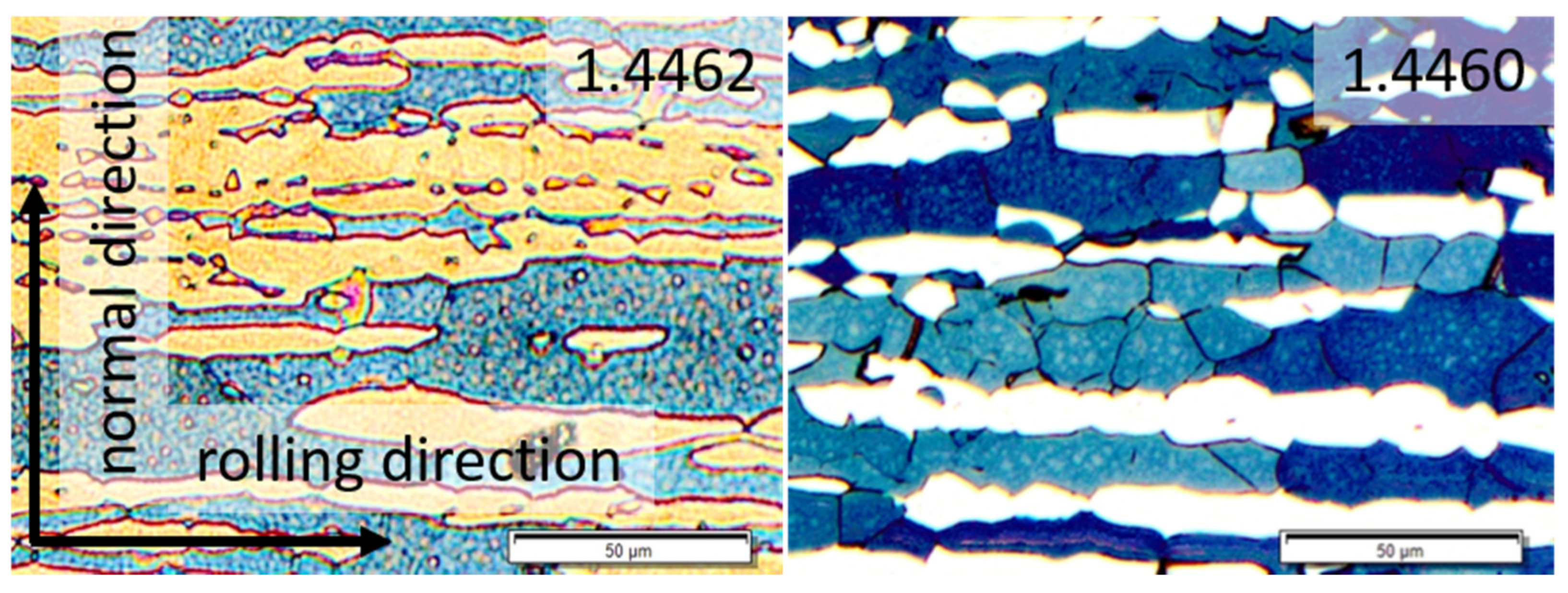
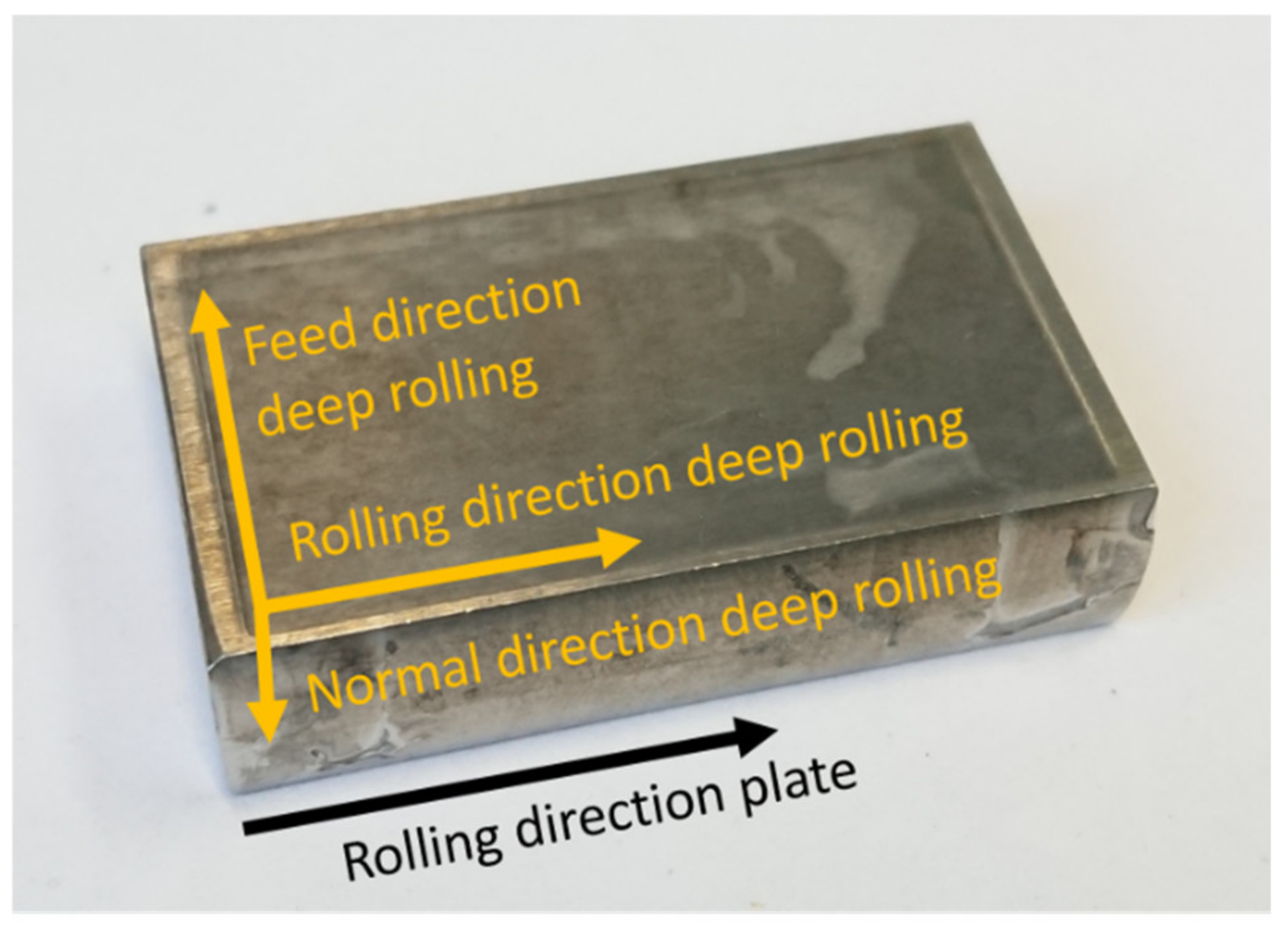


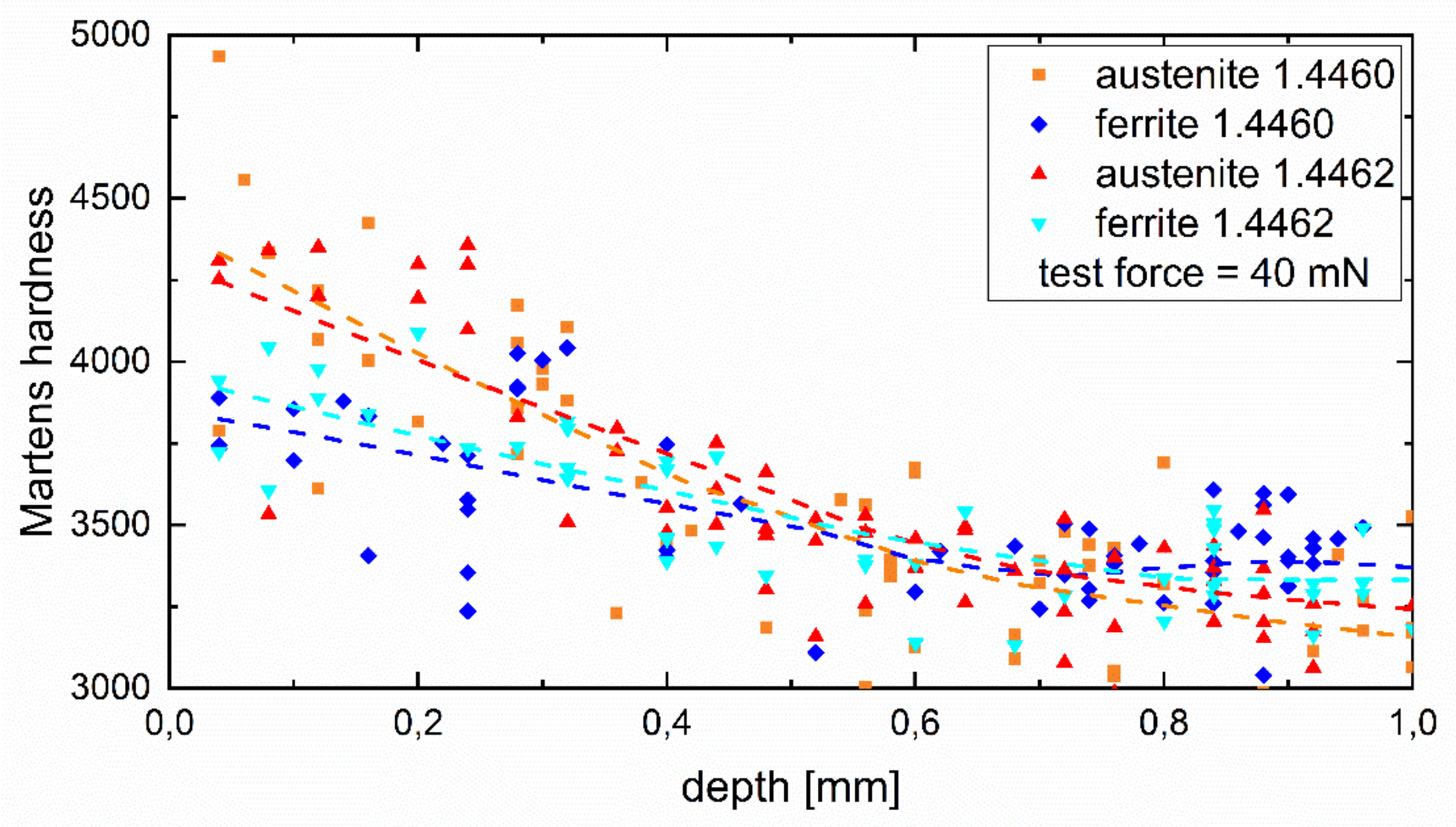

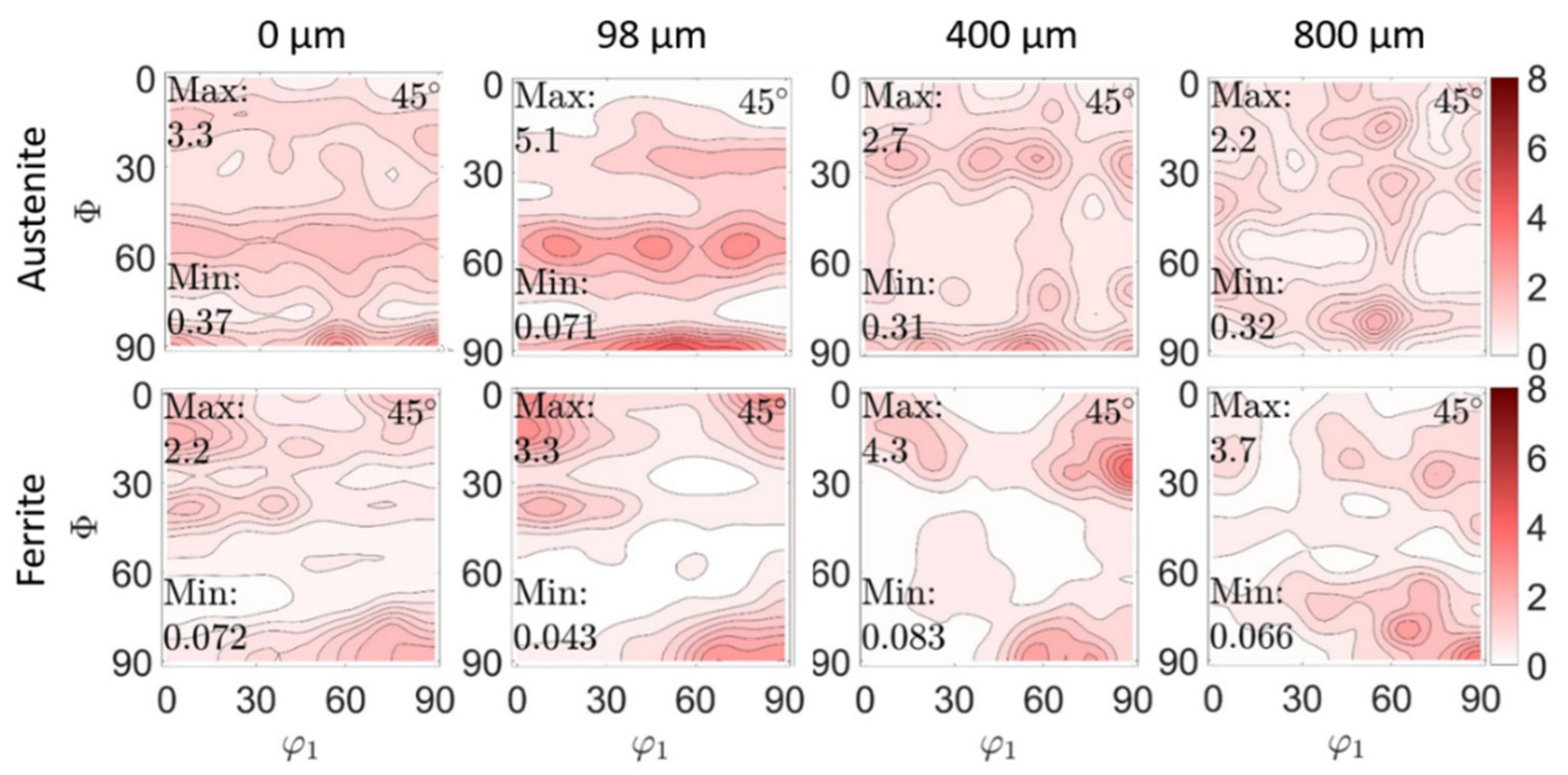

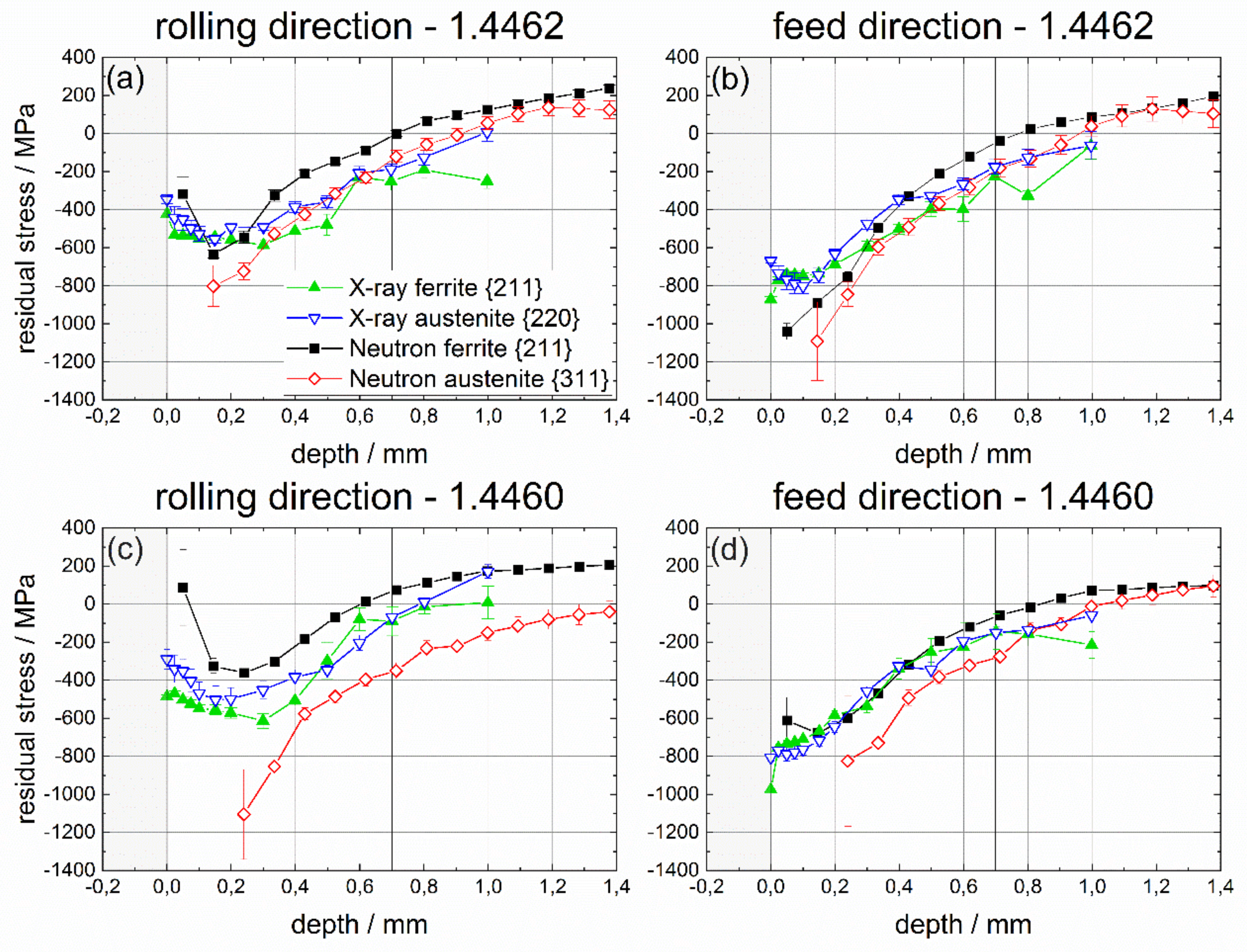
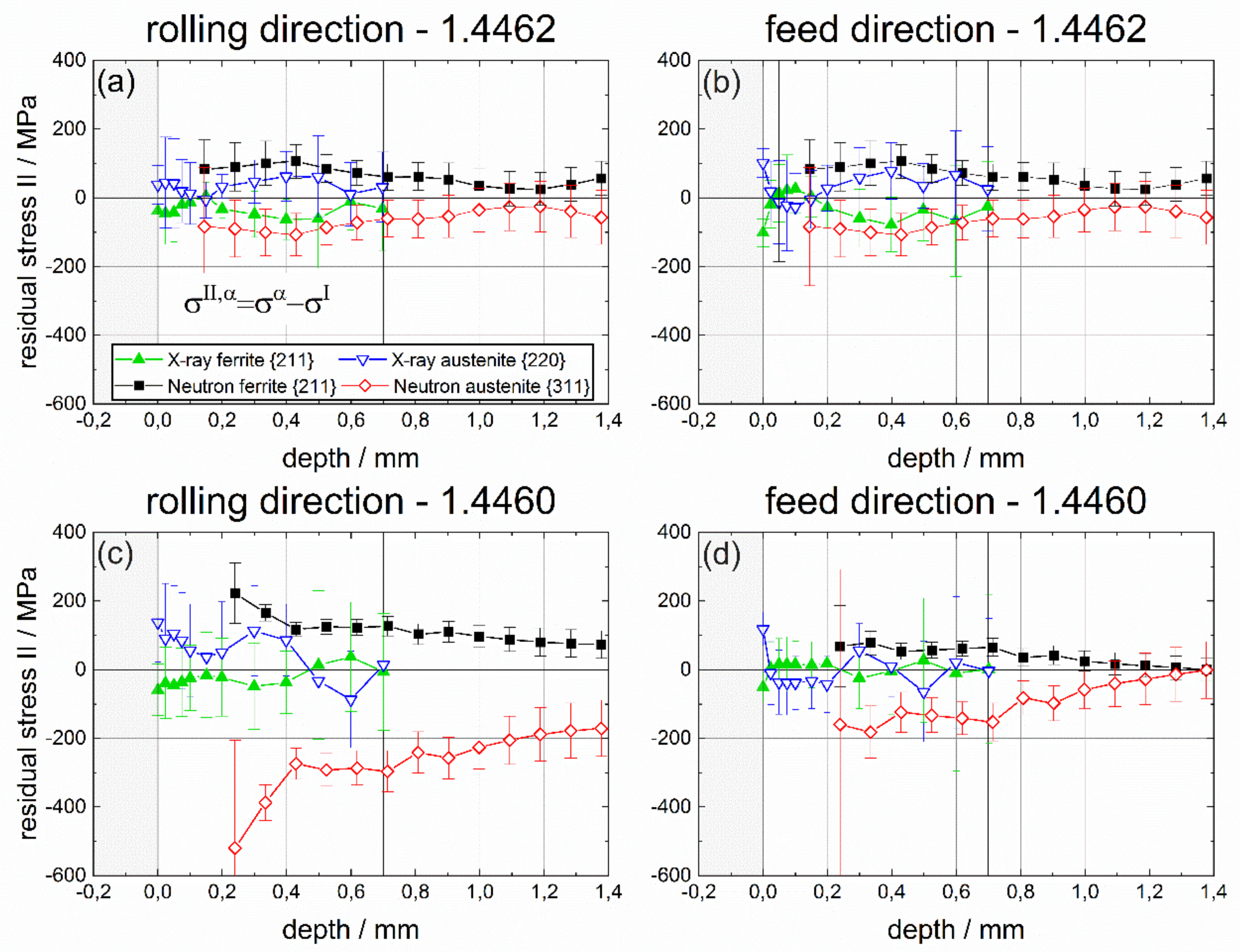

| C | C | Si | Mn | P | S | Cr | Mo | Ni | N | |
|---|---|---|---|---|---|---|---|---|---|---|
| 1.4462 | 0–0.03 | 0–0.03 | 0–1.0 | 0–2.0 | 0–0.035 | 0–0.015 | 21.0–23.0 | 2.5–3.5 | 4.5–6.5 | 0.1–0.22 |
| 1.4460 | 0–0.05 | 0–0.05 | 0–1.0 | 0–2.0 | 0–0.035 | 0–0.03 | 25.0–28.0 | 1.3–2.0 | 4.5–6.5 | 0.05–0.20 |
| Nominal Ferrite Content/% | Measured Ferrite Content/% | Nominal Austenite Content/% | Measured Austenite Content/% | Nominal Rp0.2/MPa | Measured Yield Strength/MPa | |
|---|---|---|---|---|---|---|
| 1.4462 | 50 | 44 ± 4% | 50 | 56 ± 4% | 448 [24] | 575 |
| 1.4460 | 70 | 71 ± 10% | 30 | 29 ± 10% | 460 [25] | 630 |
| Measurement Methods | Phase | Youngs Modulus [MPa] | Poisson’s Ratio [-] | Reference |
|---|---|---|---|---|
| Neutron/X-ray | α{211} | 219,911 | 0.280 | [30] |
| Neutron | γ{311} | 177,329 | 0.341 | [29] |
| X-ray | γ{220} | 212,758 | 0.310 | [29] |
Publisher’s Note: MDPI stays neutral with regard to jurisdictional claims in published maps and institutional affiliations. |
© 2021 by the authors. Licensee MDPI, Basel, Switzerland. This article is an open access article distributed under the terms and conditions of the Creative Commons Attribution (CC BY) license (https://creativecommons.org/licenses/by/4.0/).
Share and Cite
Pulvermacher, S.; Bücker, T.; Šaroun, J.; Rebelo-Kornmeier, J.; Hofmann, M.; Gibmeier, J. Neutron and X-ray Diffraction Analysis of Macro and Phase-Specific Micro Residual Stresses in Deep Rolled Duplex Stainless Steels. Materials 2021, 14, 1854. https://doi.org/10.3390/ma14081854
Pulvermacher S, Bücker T, Šaroun J, Rebelo-Kornmeier J, Hofmann M, Gibmeier J. Neutron and X-ray Diffraction Analysis of Macro and Phase-Specific Micro Residual Stresses in Deep Rolled Duplex Stainless Steels. Materials. 2021; 14(8):1854. https://doi.org/10.3390/ma14081854
Chicago/Turabian StylePulvermacher, Samuel, Tobias Bücker, Jan Šaroun, Joana Rebelo-Kornmeier, Michael Hofmann, and Jens Gibmeier. 2021. "Neutron and X-ray Diffraction Analysis of Macro and Phase-Specific Micro Residual Stresses in Deep Rolled Duplex Stainless Steels" Materials 14, no. 8: 1854. https://doi.org/10.3390/ma14081854
APA StylePulvermacher, S., Bücker, T., Šaroun, J., Rebelo-Kornmeier, J., Hofmann, M., & Gibmeier, J. (2021). Neutron and X-ray Diffraction Analysis of Macro and Phase-Specific Micro Residual Stresses in Deep Rolled Duplex Stainless Steels. Materials, 14(8), 1854. https://doi.org/10.3390/ma14081854






